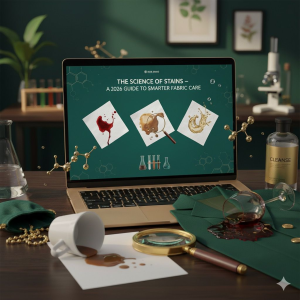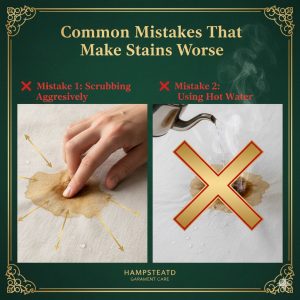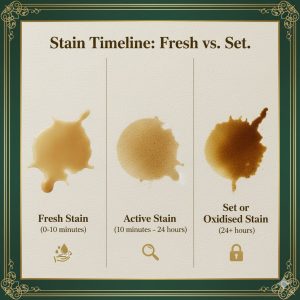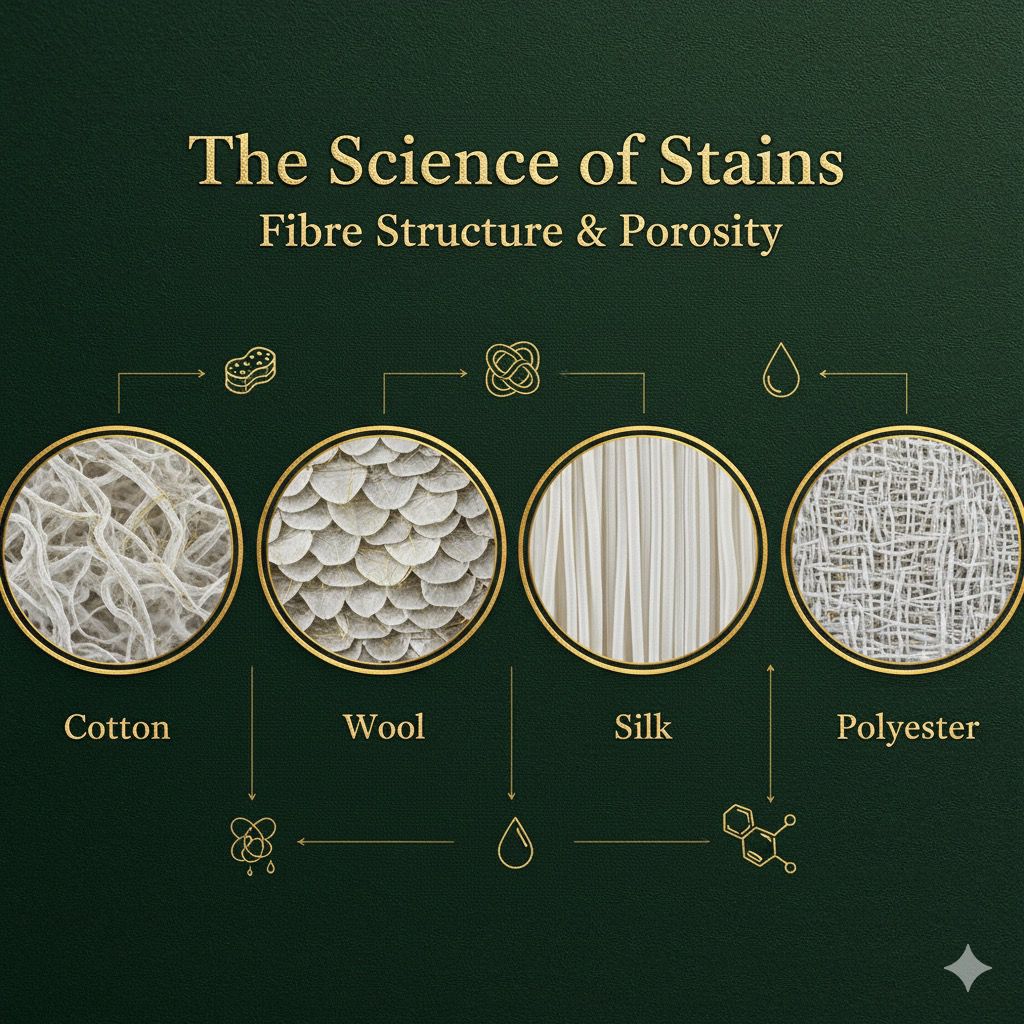The Science of Stains — A 2026 Guide to Smarter Fabric Care
 Fabrics look simple at first glance, but every material has its own personality, structure, and science behind it. Some fabrics behave like chilled, easy‑going friends — happy to bounce back after a spill — while others are more dramatic, reacting instantly and permanently to even the slightest mistake. A coffee splash on cotton might rinse out effortlessly, but the same spill on silk can turn into a long‑lasting stain that refuses to leave.
Fabrics look simple at first glance, but every material has its own personality, structure, and science behind it. Some fabrics behave like chilled, easy‑going friends — happy to bounce back after a spill — while others are more dramatic, reacting instantly and permanently to even the slightest mistake. A coffee splash on cotton might rinse out effortlessly, but the same spill on silk can turn into a long‑lasting stain that refuses to leave.
With modern wardrobes filled with new blends, recycled fibres, stretchy synthetics, performance fabrics, and luxury textiles, understanding how stains behave is essential. The more you know, the easier it is to protect your clothes — and avoid costly damage.
This ultimate 2026 guide teaches you how stains form, how different fibres react, and how to clean safely at home without making things worse. And when home treatment isn’t enough, you’ll know exactly when to bring your garment to Hampstead Garment Care for professional cleaning.
This fully expanded guide will help you:
-
Understand why fabrics react differently to spills and stains
-
Learn the science behind stain absorption, heat sensitivity, surface charge, and fibre structure
-
Identify which stains have a “golden window” for treatment
-
Spot signs that a stain is oxidising or setting permanently
-
Recognise fabrics that you should never wash at home
-
Use safe cleaning techniques without damaging fibres
-
Avoid common mistakes that shrink, bleach, distort, or weaken garments
-
Decide confidently when professional cleaning is the safest choice
-
Build long‑term habits to keep your clothes fresh and lasting longer
Why Fabrics React Differently — The Real Science
Understanding why fabrics behave differently isn’t just interesting — it’s the foundation of effective stain removal. Each fabric has its own internal architecture, chemical makeup, and response to moisture, heat, oils, and dyes. When you truly understand these characteristics, you stop guessing and start cleaning smart. Below, each section has been expanded with deeper explanations, real‑world scenarios, and insights from professional cleaners so readers get a complete, rich understanding of fabric behaviour.
Different fabrics respond differently to stains because of how they’re built — right down to their microscopic structure. Some fibres behave like open‑hearted hosts, absorbing anything that touches them, while others act more like stubborn surfaces that refuse to let go once a stain sticks. These differences explain why one garment survives a spill with no problem, while another is practically ruined by the same accident.
Think of fabrics like different personalities: cotton is easy‑going and predictable, wool is sensitive and reactive, silk is elegant but fragile, and polyester is strong but clingy with oils. When you understand these “personalities,” cleaning becomes less of a mystery and more of a strategy.
In real‑world terms, this means a coffee spill on cotton might rinse out with nothing more than a flush of cold water, while a few drops of deodorant on polyester could turn into a greasy, yellowish mark that gets more visible over time. Wool may let a wine droplet sit on the surface at first — but rub it, and suddenly the stain dives deep into the scales.
These microscopic details of fibre structure, surface charge, porosity, and heat sensitivity determine how stains spread, absorb, and bond. And once you recognise these patterns, you can instantly decide whether a stain is safe to treat at home or whether it needs professional care.
Understanding fabric behaviour is also more critical than ever in 2026, because today’s clothing isn’t just cotton, wool, or silk. We now deal with:
-
Recycled polyester blends
-
Performance fabrics with coatings
-
Stretchy elastane‑infused garments
-
Semi‑synthetics like viscose and modal
-
Luxury fibres like alpaca and cashmere
Each of these materials reacts differently to stains — sometimes unpredictably. That’s why learning the science behind the fabric helps prevent irreversible mistakes and keeps your wardrobe looking sharp for longer.
1. Fibre Structure
Every fibre behaves differently because of what it’s made from — and these microscopic structures influence everything from how stains spread to how easily they can be removed. Fibres can be smooth, scaly, porous, tightly twisted, or chemically treated, and these characteristics determine whether a stain sinks in, sits on top, or bonds permanently.
-
Cotton – A natural cellulose fibre made of twisted ribbon‑like strands. Highly breathable and absorbent, which is why liquids soak in fast. But because the structure is open and flexible, cotton also releases many stains easily — unless heat sets them. Think of cotton like a sponge that can be rinsed clean if treated quickly.
-
Wool – A protein fibre covered in tiny overlapping scales. These scales behave like Velcro: heat or friction causes them to latch together, shrinking or felting the wool. Stains may sit on the surface at first, but rubbing pushes them deeper into the scales, making removal more challenging. Wool fibres can also swell when wet, distorting the garment’s shape.
-
Silk – A smooth, protein‑based filament that is naturally glossy and extremely fine. Silk’s long, sleek fibres make it sensitive to pH changes, friction, and water spotting. Because the surface is so smooth, stains often spread outward instead of sinking in — especially oils and dyes — creating noticeable marks.
-
Polyester – A petroleum‑based synthetic with a very tight, non‑porous structure. It repels water but attracts oils because of its chemical makeup. This makes polyester resistant to some stains but extremely stubborn with oily ones. Once oils bond, they can be difficult to lift without the right chemistry.
-
Viscose/Rayon – A semi‑synthetic fibre derived from wood pulp. Extremely absorbent but becomes weak when wet. The fibres swell, lose strength, and can stretch or distort, which is why viscose garments often change shape during cleaning. Stains may absorb quickly, but removing them safely is tricky.
-
Blends (cotton‑poly, wool‑silk, etc.) – Blended fabrics combine the strengths of each fibre — and unfortunately, the weaknesses too. For example, a cotton‑poly shirt may absorb stains like cotton but hold oils like polyester. A wool‑silk blend can shrink like wool but stain like silk.
Real‑world example: A curry spill on cotton may rinse out with detergent, but the same spill on a cotton‑poly blend can leave an oily shadow because the polyester portion traps the oil. Meanwhile, a drop of perfume on silk may create a circular stain within seconds because the alcohol disrupts the fragile protein structure.
A stain behaves differently depending on the “personality” of the fibre — absorbent, hydrophobic, delicate, textured, or static‑prone.
2. Porosity
Porosity determines how quickly and how deeply a fabric absorbs liquids — and this single trait can completely transform how a stain behaves. A porous fabric behaves almost like a thirsty sponge, pulling moisture into its inner structure within moments. On the other hand, low‑porosity fabrics resist water at first but tend to cling stubbornly to oils, creams, and sweat residues.
Porosity also affects the shape and movement of a stain. A tannin stain (like tea or wine) on cotton may create a large, softly faded ring because the liquid spreads rapidly, but the same spill on polyester may bead for a moment before slowly sinking in, creating a tighter, more defined mark.
Here’s a deeper look:
-
Highly porous fabrics (cotton, linen): quickly absorb liquids, causing stains to spread deep and wide. The good news? Because of the open fibre structure, these stains often rinse out well with cold water if treated quickly.
-
Medium‑porosity fabrics (viscose, modal, bamboo blends): absorb liquids almost as fast as cotton but lose structural stability when wet. The fibres swell, stretch, and weaken, making stain removal delicate and sometimes risky.
-
Low‑porosity fabrics (polyester, nylon): repel water initially, causing spills to linger on the surface. But oils and greasy stains cling aggressively to the synthetic surface, making them among the most difficult to remove without specialised chemistry.
A perfect real‑world example: sunscreen on polyester activewear. Because the fabric is non‑porous to water but oil-attractive, the stain locks in quickly — especially once exposed to body heat — and becomes nearly impossible to remove without specific solvents or professional treatment.
Porosity is one of the most critical factors in stain removal because it determines whether you should rinse immediately, blot gently, or avoid water altogether.
3. Surface Charge. Surface Charge
Static electricity and molecular charges influence how stains attach.
-
Polyester & nylon attract dust, oils, pollution, and dyes due to static.
-
Wool traps dirt between its natural scales.
-
Silk attracts skin oils, perfume, and deodorant residue.
-
Cotton has low static charge but absorbs liquids deeply.
This explains why certain stains seem to “stick” to some fabrics more stubbornly.
4. Heat Sensitivity
 Heat is one of the most powerful – and dangerous – forces in fabric care. Even a small amount of heat can completely change how a stain behaves.
Heat is one of the most powerful – and dangerous – forces in fabric care. Even a small amount of heat can completely change how a stain behaves.
-
Protein stains (blood, milk, sweat) cook when heated, becoming permanently fixed.
-
Oil stains bond deeper into synthetic fibres like polyester when heated.
-
Tannin stains (from coffee, tea, and wine) darken and become nearly impossible to remove.
-
Dye stains spread and lock into delicate fibres such as silk.
Heat doesn’t just affect stains — it affects the fibres themselves:
-
Wool shrinks and felts.
-
Silk loses its sheen and becomes brittle.
-
Viscose weakens and distorts.
-
Polyester melts or becomes shiny when ironed at too high a temperature.
General rule: Never apply heat until the stain is entirely removed. This includes tumble drying, ironing, or washing with hot water.
5. Fabric Finish & Coatings (2026 Update)
Modern garments often have specialised coatings and finishes that dramatically affect how stains behave and how safely a fabric can be cleaned. These coatings are designed to improve performance, durability, comfort, and appearance — but they also complicate stain removal.
Common finishes include:
-
Water‑resistant sprays: These help liquids bead up on the surface rather than soak in. But once the coating wears down unevenly, stains may penetrate unpredictably.
-
Flame retardants: Found in children’s clothes, uniforms, and workwear. These chemicals can react badly with strong detergents or heat.
-
Anti‑static coatings: Used on synthetics to reduce clinging. However, they sometimes attract oils, lotions, and particles from pollution.
-
Stretch treatments (elastane blends): These give garments flexibility, but heat and harsh chemicals can break down the stretch fibres, causing sagging or loss of elasticity.
Finishes change how stains interact with the surface. For example, water‑repellent fabrics may resist a coffee spill at first — the liquid rolls off like a bead — but oils from sunscreen or makeup can bypass the coating and embed deeply. Similarly, flame‑retardant fabrics may discolour or weaken when treated with the wrong cleaning agents.
Some coatings repel water but hold onto oils, making cleaning trickier. Understanding the finish on your garment helps ensure you choose the safest and most effective cleaning method, especially for high‑performance or delicate items.
Types of Stains in 2026 — And Why They Matter
Every stain belongs to a chemistry category. Treating the wrong way makes things worse.
Protein Stains
Protein-based stains from bodily fluids like blood, sweat, milk, and egg react to heat by tightening and bonding deeply with fabrics, making removal difficult. Immediate rinsing with cold water is crucial, along with gentle agitation and enzyme-based detergents to break down the proteins. If untreated, these stains can oxidise and turn yellow or brown over time, particularly in areas such as shirt collars and underarms.
Oil & Grease Stains
Cooking oil, butter, lotion, sunscreen, makeup, and body oils fall into this category. These stains are particularly stubborn because oils cling to fabrics using hydrophobic (water-repelling) bonds. Synthetic fibres like polyester or nylon attract oils even more strongly due to their chemical structure, which can cause oily stains to spread, darken, and settle into the fabric. These stains often resist regular washing unless pre-treated with dish soap or a degreasing agent that can break down oils. Heat from the body, sunlight, or dryers causes the oil to bond more deeply, creating an almost invisible halo that becomes more visible over time.
Tannin Stains
Coffee, tea, red wine, and fruit juice are familiar sources of tannin stains. Tannins are natural plant-based compounds that act like dyes — they’re designed to cling to surfaces. These stains often look light at first but darken quickly as they dry or when heat is applied. Because tannins react poorly to alkaline substances, the wrong detergent can actually worsen them. Cold water and a tannin-specific remover are ideal. Spill a cup of tea on cotton, and you’ll see how quickly the stain spreads; spill the same on wool, and it may sit on the surface but become impossible to remove if rubbed.
Dye Stains
Spices, berries, curry, pigments, and colour transfer from other garments fall into this category. Dye stains are highly aggressive because their molecules are designed to bond tightly — that’s their job as dyes. They can bleed, spread, and sink into fibres when exposed to moisture, especially during washing. These stains often require targeted, professional treatment. For example, turmeric or beetroot on cotton may leave bright, stubborn marks that deepen over time.
Oxidisable Stains
Old sweat, grass, and wine exposed to air are common oxidisable stains. These stains undergo a chemical reaction with oxygen, darkening over time. The longer they sit, the deeper they bond into the fibres. Sweat stains around collars and armpits often turn yellow because of oxidation combined with deodorant chemicals. Removing oxidised stains usually requires oxygen-based treatments or professional methods, as regular washing won’t lift them once they’ve chemically bonded.
Particulate Stains
Soil, dust, clay, and pollution are particulate stains. Unlike liquid stains that soak into fibres, particulates sit on the surface — but textured fabrics like wool or fleece can trap them easily. These stains are composed of tiny solid particles that embed in the fabric’s microscopic spaces. A quick brushing or shaking works for fresh stains, but older ones often need deeper cleaning. For example, mud on cotton can be rinsed off once dry, but clay on suede or textured wool can cling stubbornly without professional care.
Cotton — The Friendly, Easy-to-Clean Fabric
Cotton is one of the easiest fabrics to maintain, but it must still be treated correctly.
Why Cotton Stains the Way It Does
Cotton absorbs fast because it’s hydrophilic — meaning it naturally attracts water and anything dissolved in it. This makes cotton incredibly comfortable to wear, but also quick to soak up spills.
-
Stains soak in fast because cotton fibres act like tiny, twisted ribbons with open spaces that pull liquid inward.
-
But they also wash out easily because cotton’s structure doesn’t cling tightly to most stain molecules, allowing them to be flushed out with cold water.
-
Unless heat sets them, because heat causes the absorbed stain to bind deeper into the cellulose structure, making it more challenging — sometimes impossible — to remove.
In simpler terms, cotton behaves exactly like a sponge: if you spill coffee on a cotton shirt, the liquid spreads instantly into the fibres. But if you rinse it immediately with cold water, most of the stain lifts because cotton doesn’t grip onto the molecules too tightly. The danger comes when cotton comes into contact with heat too soon — like putting a stained shirt in the dryer or washing it in hot water. Heat “locks in” the stain, making it far more stubborn and requiring stronger treatments or professional cleaning.
This hydrophilic nature is also why cotton often absorbs sweat, deodorant, and body oils more easily than synthetics — but luckily, with proper care, these stains can be reversed before they turn into permanent yellowing.
Cotton behaves like a sponge — great for comfort, but quick to drink up spills. For example, if you drop tomato sauce on a cotton T‑shirt, the stain spreads instantly. But the good news? Cotton fibres don’t hold the stain as tightly as synthetics, so with the proper treatment, even stubborn marks like curry or iced coffee usually lift well. Cotton also reacts predictably, making it one of the safest fabrics for home stain removal, as long as you avoid heat during the early stages.
Safe Cleaning for Cotton
 Cotton may be sturdy, but giving it the proper treatment ensures stains lift smoothly and the fibres stay bright and strong for years. The goal is always to loosen the stain gently without forcing it deeper.
Cotton may be sturdy, but giving it the proper treatment ensures stains lift smoothly and the fibres stay bright and strong for years. The goal is always to loosen the stain gently without forcing it deeper.
-
Cold water immediately
-
Mild or enzyme detergent
-
Dish soap for oils
-
Vinegar solution (properly diluted) for tannin stains
Avoid
Cotton can tolerate a lot, but even this tough fabric has limits. Using the wrong method can actually harden the stain or damage the natural fibres.
-
Hot water before stain removal
-
Aggressive scrubbing
-
Leaving damp cotton in a pile (causes mildew)
Extra Tips
Cotton may seem simple, but proper care makes a huge difference in how long your garments last. Treating stains quickly keeps whites brighter, prevents yellowing, and helps colours stay vibrant. Many people don’t realise that cotton gradually builds up detergent residue, deodorant, and body oils — all of which make future stains more complicated to remove. Giving cotton items a gentle pre‑treatment and an occasional deep clean keeps them fresh and restores their natural softness.
-
Old cotton stains may need oxygen bleach (never chlorine).
-
Always test colourfastness before using vinegar.
Wool — Warm, Expensive, and Sensitive
Wool is unique because of its protein makeup and scale structure.
Why Wool Is Difficult to Clean
Wool is unique because of its protein makeup and scale structure.
-
Heat shrinks wool
-
Rubbing feels the fibres
-
Alkaline detergents damage keratin
-
Water can distort wool garments
Imagine wool-like, delicate hair—too much heat, rough handling, or strong shampoo can cause chaos. A small splash of red wine on a wool coat, for example, can sit on the surface at first, but rubbing pushes the stain deep into the scales. Even rainwater can cause rippling or changes in texture. That’s why wool needs slow, gentle, controlled cleaning methods to preserve shape and softness.
Safe Cleaning
Wool needs slow, gentle handling, almost like caring for delicate hair. When you treat wool calmly, the fibres soften, open slightly, and release stains far more effectively. Rushing the process or moving the fabric too quickly shocks the fibres, causing them to tighten, felt, or shrink. Think of cleaning wool as guiding it rather than forcing it — giving it the space and time it needs to naturally let go of the stain without losing its shape, texture, or softness.
-
Wool-safe detergent only
-
Cold or lukewarm water
-
Soak, never scrub
-
Dry flat
Avoid
-
Hot water
-
Machine agitation
-
Squeezing or twisting
When to Professionally Clean
-
Suits
-
Coats
-
Cashmere
-
Luxury wool blends
These pieces are too expensive and too delicate to risk.
Silk — Beautiful but Extremely Delicate
Silk reacts to almost everything.
Why Silk Stains Easily
Silk reacts to almost everything.
-
Sensitive to pH changes
-
Sunlight weakens it
-
Water can leave rings
-
Oils soak in instantly
Silk behaves like a luxurious but high‑maintenance guest — stunning, but easily offended. A drop of perfume, a splash of champagne, or even rain can leave marks that spread through the protein structure. A simple foundation stain can travel along silk’s smooth filament surface and darken within minutes. Because the fibres are so delicate, stains often sit visibly on the surface, making silk both beautiful and extremely challenging to treat at home.
Safe Cleaning (Only for Minor Stains)
Even though silk is delicate, minor surface stains can sometimes be handled at home — as long as you move slowly, use minimal water, and avoid harsh chemicals.
-
Cold water rinse
-
Very gentle detergent
-
Minimal handling
Never Use
-
Vinegar — Although often recommended in home‑cleaning hacks, vinegar is acidic. It can weaken silk’s protein structure, causing the fibres to lose strength, dull their natural shine, and even create permanent discolouration.
-
Lemon juice — Highly acidic and photosensitive. It can bleach silk, leave pale patches, or cause uneven lightening, especially when exposed to sunlight afterwards.
-
Alcohol — Perfume, hand sanitiser, and rubbing alcohol break down silk’s delicate fibres. They can spread the stain, dissolve dyes, and leave harsh rings that are almost impossible to reverse.
-
Machine cycles — Even the gentlest cycle is too aggressive for silk. The movement, water pressure, and temperature fluctuations can distort the shape, damage the weave, or cause snagging and stretching.
-
Scrubbing or wringing — Silk should never be rubbed or twisted. Friction roughens the smooth filament surface, leading to texture damage, fibre breakage, and visible abrasion marks that cannot be repaired.
Silk stains — especially oil or dye — almost always need professional cleaning.
Polyester & Synthetics — Tough but Oil-Loving
Polyester is durable, but it’s a magnet for oils.
Why Polyester Holds Stains
Polyester may be strong and wrinkle‑resistant, but its synthetic structure can tightly bind oily molecules. This makes stain removal a battle between chemistry and fibre design.
Because polyester is hydrophobic, oils cling tightly to it.
Safe Cleaning
-
Dish soap pre-treatment
-
Enzyme detergents
-
Warm wash (not hot)
Avoid
-
Heat before stain removal
-
Fabric softener on active stains (locks oils in)
Extra Notes
-
Deodorant marks often need targeted treatment
-
Makeup stains on polyester can be stubborn
Luxury Fibres — Cashmere, Mohair, Alpaca
These fibres are expensive, soft, and highly fragile.
Why Luxury Fibres Require Caution
-
They stretch when wet
-
They shrink with heat
-
Their fibres pill easily
These fibres are too luxurious and too sensitive to risk DIY attempts. Even small mistakes can lead to stretching, felting, or permanent texture changes.
-
Cashmere coats
-
Mohair knits
-
Alpaca scarves or outerwear
Stain Treatment — The Golden Rules
Your First Response Matters Most
In stain removal, timing is everything. The first move you make often determines whether the stain lifts easily or becomes a long‑term resident in your fabric.
-
Blot — never rub.
-
Use cold water only.
-
Remove solids carefully.
-
Keep heat away.
-
If unsure, stop and bring it to us.
Rubbing, heat, pressure, or the wrong chemical can turn a fixable stain into a permanent one.
Standard Stain Solutions — Quick Reference
These quick solutions work well because they match the stain’s chemistry with the right kind of treatment — something most people overlook.
-
Coffee on cotton: cold water + diluted vinegar
-
Oil on polyester: dish soap
-
Wine on wool: blot only
-
Ink on silk: professional cleaning only
-
Makeup on synthetics: enzyme detergent + gentle agitation
-
Sweat on shirts: cold water + oxygen bleach
How Modern Dry Cleaning Works in 2026
Dry cleaning today is safer, greener, and more precise than ever.
What Professional Cleaning Uses
Professional cleaning isn’t random — it’s a science-based process. Every solvent, detergent, and machine cycle is chosen to target specific fibre and stain behaviour.
-
Eco‑solvents instead of old chemicals
-
Controlled water levels for delicate wet‑cleaning
-
Intelligent machines that monitor:
-
pH
-
Temperature
-
Drum motion
-
Detergent concentration
-
Benefits
-
Protects delicate fibres
-
Removes stains safely
-
Prevents shrinkage and distortion
-
Revives texture, colour, and softness
When You Should Always Use Professional Cleaning
 Some items are too fragile or valuable to risk.
Some items are too fragile or valuable to risk.
-
Wool coats
-
Tailored suits
-
Silk garments
-
Cashmere
-
Luxury fabrics
-
Old, oxidised, or set stains
-
Oil stains on synthetics
-
Designer items or sentimental garments
Health Risks of Ignoring Stains
Stains aren’t just about appearance.
If left untreated:
-
Mould can grow
-
Bacteria can develop
-
Fabrics can weaken
-
Odours become permanent
-
Sweat stains can cause yellowing or fibre damage
Proper cleaning protects both your garment and your health.
Additional Real‑World Examples — How Stains Behave in Everyday Life
To make the science easier to understand, here are real situations you’ve likely experienced — and what the fabric was doing on a microscopic level.
Example 1: Coffee on a Cotton Shirt
The cotton absorbs the liquid instantly because it’s porous. The stain spreads outward, but because the fibres are hydrophilic, cold water will release much of it.
Example 2: Red Wine on a Wool Coat
Wool’s tiny scales trap the pigment at the surface. Blotting works, but rubbing forces the stain deeper. Heat from the body or a heater can set the tannins.
Example 3: Sunscreen Stains on Polyester Activewear
Sunscreen contains oils + minerals that cling tightly to polyester. Heat from workouts can cause the stain to bond more deeply.
Example 4: Ink on Silk Blouse
Silk reacts instantly with dyes. The stain penetrates the protein bonds, making it nearly impossible to remove without professional-grade chemicals.
 How Stains Change Over Time — Fresh vs. Aged Stains
How Stains Change Over Time — Fresh vs. Aged Stains
All stains go through three phases. Understanding these phases helps you decide whether home treatment is safe.
1. Fresh Stains (0–10 minutes)
-
Easiest to remove
-
Not yet bonded to fibres
-
Respond well to cold water
2. Active Stains (10 minutes – 24 hours)
-
Begin reacting with fabric chemistry
-
Oils start bonding
-
Tannins begin oxidising
-
Protein stains start setting
3. Set or Oxidised Stains (24+ hours)
-
Molecules chemically bond to fibres
-
Darken over time
-
Harder to remove even professionally
-
Heat makes them permanent
If a stain has been sitting for more than a day, home methods can make it worse.
Mistakes That Make Stains Worse (But Everyone Does Them)
Even well‑meaning attempts at cleaning can cause long‑term damage.
❌ Mistake 1: Using Hot Water
Sets protein, oil, and tannin stains.
❌ Mistake 2: Scrubbing Aggressively
Breaks fibres, pushes stains deeper, distorts delicate fabrics.
❌ Mistake 3: Using the Wrong Detergents
Alkaline detergents ruin wool and silk.
❌ Mistake 4: Relying on TikTok or “Home Hacks”
Lemon, baking soda, toothpaste, and hairspray — all can burn or bleach fabrics.
❌ Mistake 5: Using Bleach on Coloured Garments
“Brightening” turns into fading, yellowing, or fibre damage.
Fabric‑Specific Do’s and Don’ts (2026 Edition)
This quick guide helps you avoid the most significant risks.
Cotton
Do: Pre‑treat stains, use cold water, and wash normally.
Don’t: Use hot water before stain removal.
Wool
Do: Use wool detergent, reshape while damp.
Don’t: Agitate or wring — ever.
Silk
Do: Blot gently, avoid sunlight.
Don’t: Use vinegar or alcohol.
Polyester
Do: Pre‑treat oils.
Don’t: Add heat before stain removal.
Viscose
Do: Handle gently, reshape flat.
Don’t: Rub or stretch.
Luxury Fibres
Do: Seek professional care.
Don’t: Wash at home.
When Home Cleaning Is Safe — And When It Isn’t
Not every stain needs professional care, but knowing the limits prevents expensive mistakes.
Safe to Clean at Home
-
Fresh stains on cotton
-
Non‑oil stains on polyester
-
Light sweat marks
-
Small food spills (except oily ones)
Needs Professional Cleaning
-
Silk stains (any type)
-
Wine stains on wool
-
Oil stains on synthetics
-
Ink on any delicate fibre
-
Old or oxidised stains
-
Luxury garments (cashmere, mohair, alpaca)
Why Professional Cleaning Is Different — Behind the Scenes
Professional cleaning is not “just washing with better machines.” It is a controlled scientific process.
What Hampstead Garment Care Uses
-
pH‑controlled detergents that protect protein fibres like wool and silk
-
Specialist spotting agents for oils, dyes, ink, rust, tannins, and proteins
-
Temperature‑controlled cycles to prevent shrinking or felting
-
Solvent‑based dry cleaning for delicate fibres
-
Advanced wet‑cleaning for eco‑friendly, fabric‑safe methods
Why It Works Better
-
The solvents dissolve oils that water cannot touch
-
The machines agitate gently to avoid damage
-
Technicians understand fibre chemistry and stain behaviour
-
Professional drying prevents distortion or shrinkage
Costly Stain Scenarios We See Every Week
At Hampstead Garment Care, we regularly save garments that customers feared were ruined.
Scenario 1: White Shirt with Yellow Sweat Stains
These oxidise over time. Professional oxygen treatment + pH balancing revives the fabric.
Scenario 2: Oil Splatter on a Silk Top
Home scrubbing spreads the oil. Our solvent treatment lifts it without damaging the silk.
Scenario 3: Red Wine on a Wool Coat
We use tannin removers and controlled drying to restore the coat safely.
Scenario 4: Makeup on Polyester Dress
Synthetic fibres often require enzyme treatment and a solvent rinse.
Care Labels — Why They Matter More Than People Think
Care labels are not suggestions — they are instructions based on laboratory testing.
What Care Labels Tell You
-
Maximum safe temperature
-
Whether agitation is allowed
-
Whether heat drying is safe
-
Whether solvents can be used
-
Whether shrinkage risk exists
Ignoring labels is one of the top causes of:
-
Shrinkage
-
Colour bleeding
-
Texture changes
-
Permanent stains
Prevention — The Best Form of Stain Management
Most stains can be avoided with small, simple changes in how you handle, wear, and store your clothes. Prevention is always cheaper — and safer — than cure.
You can avoid most stains by developing simple habits.
Everyday Prevention Tips
-
Wear aprons when cooking
-
Use scarf protectors for makeup transfer
-
Avoid applying perfume directly onto fabrics
-
Store clothes properly to avoid yellowing
-
Keep white shirts away from deodorants with aluminium
Long‑Term Care Tips
-
Rotate clothing to reduce wear
-
Clean seasonal items before storing
-
Use breathable garment bags
-
Avoid direct sunlight for silk and wool
Fabric & Stain Comparison Table (Quick Diagnosis Guide)
Below is an easy, quick-reference table your readers can use to instantly identify the safest cleaning method for each fabric and stain type.
| Fabric Type | Common Stains | Home‑Safe Treatment | Avoid | Professional Needed? |
|---|---|---|---|---|
| Cotton | Coffee, sweat, food, grease | Cold water, mild detergent, dish soap for oils | Hot water, scrubbing | Only for old/oxidised stains |
| Wool | Wine, sweat, dirt | Blotting, wool detergent, cold soak | Heat, agitation, wringing | Yes — most stains |
| Silk | Oil, dye, makeup, ink | Gentle blotting only | Vinegar, alcohol, water rings, and machine wash | Always |
| Polyester | Deodorant, makeup, body oil | Dish soap pre‑treat, warm wash | Heat on fresh stains | Oils, sunscreen, set stains |
| Viscose | Drinks, food, dye | Gentle dabbing, reshape flat | Rubbing, stretching | Often |
| Cashmere | Sweat, oils, light food stains | Very gentle blotting | Any water agitation | Always |
| Linen | Coffee, wine, dirt | Cold water, detergent | Hot water | Only heavy tannins/dye stains |
Fabric Behaviour Chart (Why Some Stains Stick)
This chart helps readers understand why certain stains bond to certain fibres.
| Fabric | Porosity | Surface Charge | Oil Attraction | Heat Sensitivity | Difficulty Level |
| Cotton | High | Low | Low | Medium | Easy |
| Wool | Medium | Medium | Medium | Very High | Hard |
| Silk | Low | Medium | High | Extremely High | Very Hard |
| Polyester | Very Low | High | Very High | Medium | Medium‑Hard |
| Viscose | Medium‑High | Low | Medium | High | Hard |
| Cashmere | Medium | Medium | Medium | Very High | Very Hard |
Quick “Stain Doctor” Guide — Diagnose Your Stain in 10 Seconds
Use this cheat sheet to identify your stain before choosing a cleaning method.
| Stain Looks Like… | Likely Type | Action |
| Brown spreads fast, smells like coffee/tea | Tannin | Cold water + vinegar (not for wool/silk) |
| Dark patch, feels oily | Oil/grease | Dish soap pre‑treat |
| Red/purple, spreads when wet | Wine/berry (tannin+dye) | Blot only; no heat |
| Yellow, old, stiff | Oxidised sweat | Oxygen bleach (cotton only) |
| Blue/black sharp lines | Ink | Professional only |
| Grey dust, surface layer | Particulate | Shake + gentle brushing |
Frequently Asked Questions (FAQ)
1. What is the most complex type of stain to remove?
Oil‑based stains and oxidised (old) stains are the most difficult because they bond chemically to fibres.
2. Is it safe to use bleach on clothes?
Only oxygen bleach on white cotton. Never use chlorine bleach on colours, wool, or silk.
3. Why do sweat stains turn yellow?
It’s a chemical reaction between sweat, deodorant, and air — this oxidation needs professional treatment.
4. Can vinegar remove stains?
Only tannin stains on cotton. It will damage wool or silk.
5. When should I avoid home cleaning altogether?
Silk, cashmere, mohair, alpaca, old stains, oil stains on synthetics, and any item with sentimental or high financial value.
Myth vs Fact — 2026 Edition
| Myth | Fact |
| “Hot water removes all stains.” | Hot water sets most stains permanently. |
| “Baking soda works on everything.” | It can weaken delicate fibres and ruin silk/wool. |
| “Hairspray removes ink.” | Modern hairsprays contain oils that make stains worse. |
| “Sunlight helps dry clothes safely.” | Sunlight fades silk, wool, and dyed fabrics. |
| “If it survived one wash, it’s safe to repeat.” | Repeated wrong washing slowly destroys fibres. |
Troubleshooting Guide — When Stains Won’t Move
Problem 1: The stain spreads when I rinse it.
It’s likely a dye or tannin stain — blot, don’t rub. Seek professional help.
Problem 2: The stain turns darker after drying.
It oxidised — oxygen treatment or professional cleaning required.
Problem 3: The fabric changed shape.
Wool/viscose stretched or shrank due to water agitation. Needs professional reshaping.
Problem 4: The stain has a greasy halo.
The oil wasn’t entirely removed — re‑treat with dish soap, then wash.
Problem 5: My silk has water rings.
Only a specialist can remove these without damaging the fibre.
Care Label Symbol Guide (Designer‑Ready Descriptions)
Use these text descriptions to create matching icons for your blog.
Washing Symbols
-
Tub icon: Machine wash allowed.
-
Tub with hand: Hand wash only.
-
Tub with number: Maximum temperature.
-
Tub with line underneath: Gentle cycle.
Drying Symbols
-
Square with circle: Tumble dry.
-
Square only: Line dry.
-
Square with horizontal line: Dry flat.
Ironing Symbols
-
Iron icon: Safe to iron.
-
Iron with dot(s): Low/medium/high heat.
-
Iron crossed out: Do not iron.
Dry Cleaning Symbols
-
Circle: Dry clean.
-
Circle with letter (P/F): Solvent type.
-
Circle crossed out: Do not dry clean.
Recommended Stain Removal Products (2026 Safe List)
Home‑Safe Products
-
Mild enzyme detergent (for synthetics + cotton)
-
Wool/silk safe detergent (protein‑safe)
-
High‑quality dish soap (oil stains)
-
Oxygen bleach (white cotton only)
-
Distilled water (for delicate surface cleaning)
Professional‑Level Products (Used by Experts)
(Do not attempt at home)
-
Tannin removers
-
Protein spotters
-
Solvent‑based degreasers
-
pH‑controlled wet cleaning detergents
-
Specialist ink removers
Expert Fabric Care by Hampstead Garment Care
Protecting your garments isn’t just about cleaning — it’s about understanding the fibres, the chemistry, and the risks. When you want your clothes treated with the same care you give them, trust the experts.
Why Choose Us?
-
Professional stain removal for delicate & luxury fabrics
-
Eco‑friendly dry cleaning systems
-
Advanced wet-cleaning technology
-
Gentle pH‑controlled detergents
-
Expert technicians trained in fibre science
-
Free collection & delivery in many London areas
Book Your Expert Cleaning
📍 Address: 513 Finchley Road, Hampstead, London NW3 7BB
📞 Call: +44 02077949096
📧 Email: hampsteadgarmentcare@gmail.com
🖥 Book Online: booking.londondrycleaningcompany.com/book
Your garments deserve premium care — and we’re here to deliver it.




No comment